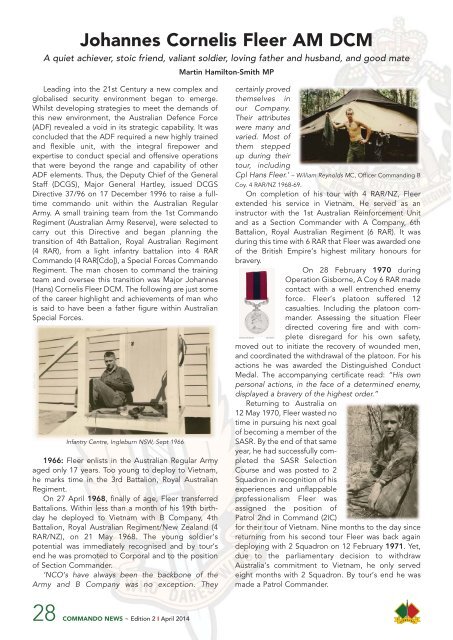AUSTRALIAN COMMANDO ASSN (NSW) INC.
Official News Magazine for the Australian Commando's featuring news, stories and current affairs.
Official News Magazine for the Australian Commando's featuring news, stories and current affairs.
You also want an ePaper? Increase the reach of your titles
YUMPU automatically turns print PDFs into web optimized ePapers that Google loves.
Johannes Cornelis Fleer AM DCM<br />
A quiet achiever, stoic friend, valiant soldier, loving father and husband, and good mate<br />
Martin Hamilton-Smith MP<br />
Leading into the 21st Century a new complex and<br />
globalised security environment began to emerge.<br />
Whilst developing strategies to meet the demands of<br />
this new environment, the Australian Defence Force<br />
(ADF) revealed a void in its strategic capability. It was<br />
concluded that the ADF required a new highly trained<br />
and flexible unit, with the integral firepower and<br />
expertise to conduct special and offensive operations<br />
that were beyond the range and capability of other<br />
ADF elements. Thus, the Deputy Chief of the General<br />
Staff (DCGS), Major General Hartley, issued DCGS<br />
Directive 37/96 on 17 December 1996 to raise a fulltime<br />
commando unit within the Australian Regular<br />
Army. A small training team from the 1st Commando<br />
Regiment (Australian Army Reserve), were selected to<br />
carry out this Directive and began planning the<br />
transition of 4th Battalion, Royal Australian Regiment<br />
(4 RAR), from a light infantry battalion into 4 RAR<br />
Commando (4 RAR[Cdo]), a Special Forces Commando<br />
Regiment. The man chosen to command the training<br />
team and oversee this transition was Major Johannes<br />
(Hans) Cornelis Fleer DCM. The following are just some<br />
of the career highlight and achievements of man who<br />
is said to have been a father figure within Australian<br />
Special Forces.<br />
Infantry Centre, Ingleburn <strong>NSW</strong>, Sept 1966<br />
1966: Fleer enlists in the Australian Regular Army<br />
aged only 17 years. Too young to deploy to Vietnam,<br />
he marks time in the 3rd Battalion, Royal Australian<br />
Regiment.<br />
On 27 April 1968, finally of age, Fleer transferred<br />
Battalions. Within less than a month of his 19th birth -<br />
day he deployed to Vietnam with B Company, 4th<br />
Battalion, Royal Australian Regiment/New Zealand (4<br />
RAR/NZ), on 21 May 1968. The young soldier’s<br />
potential was immediately recognised and by tour’s<br />
end he was promoted to Corporal and to the position<br />
of Section Commander.<br />
‘NCO’s have always been the backbone of the<br />
Army and B Company was no exception. They<br />
certainly proved<br />
themselves in<br />
our Company.<br />
Their attributes<br />
were many and<br />
varied. Most of<br />
them stepped<br />
up during their<br />
tour, including<br />
Cpl Hans Fleer.’ – William Reynolds MC, Officer Com mand ing B<br />
Coy. 4 RAR/NZ 1968-69.<br />
On com ple tion of his tour with 4 RAR/NZ, Fleer<br />
extended his service in Viet nam. He served as an<br />
instructor with the 1st Australian Reinforcement Unit<br />
and as a Section Commander with A Company, 6th<br />
Battalion, Royal Australian Regiment (6 RAR). It was<br />
during this time with 6 RAR that Fleer was awarded one<br />
of the British Empire’s highest military honours for<br />
bravery.<br />
On 28 February 1970 during<br />
Operation Gisborne, A Coy 6 RAR made<br />
contact with a well entrenched enemy<br />
force. Fleer’s platoon suffered 12<br />
casual ties. Including the platoon com -<br />
mander. Assessing the situation Fleer<br />
directed covering fire and with com -<br />
plete disregard for his own safety,<br />
moved out to initiate the recovery of wounded men,<br />
and coordinated the withdrawal of the platoon. For his<br />
actions he was awarded the Distinguished Conduct<br />
Medal. The accompanying certificate read: “His own<br />
personal actions, in the face of a determined enemy,<br />
displayed a bravery of the highest order.”<br />
Returning to Australia on<br />
12 May 1970, Fleer wasted no<br />
time in pursuing his next goal<br />
of becoming a member of the<br />
SASR. By the end of that same<br />
year, he had successfully com -<br />
pleted the SASR Selec tion<br />
Course and was posted to 2<br />
Squadron in recognition of his<br />
experiences and unflappable<br />
professional ism Fleer was<br />
assigned the position of<br />
Patrol 2nd in Command (2IC)<br />
for their tour of Vietnam. Nine months to the day since<br />
returning from his second tour Fleer was back again<br />
deploying with 2 Squadron on 12 February 1971. Yet,<br />
due to the parliamentary decision to withdraw<br />
Australia’s commitment to Vietnam, he only served<br />
eight months with 2 Squadron. By tour’s end he was<br />
made a Patrol Commander.<br />
28 <strong>COMMANDO</strong> NEWS ~ Edition 2 I April 2014

















